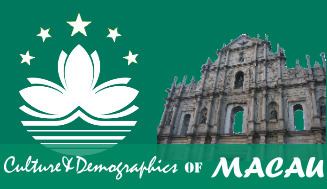 | ||
People and languages
The two official languages of Macau are Portuguese and Chinese, only spoken by a minority. English is also widely spoken. The Macanese language, generally known as Patuá, is a distinctive Creole that is still spoken by several dozen Macanese, an ethnic group of mixed Asian and Portuguese ancestry that accounts for a small percentage of Macau's population.
Contents
- People and languages
- Cultural identity
- Mass media
- Cuisine
- Religion
- Chinese traditional medicine
- Film
- Music
- Literature
- Cantonese Opera
- Facilities
- References
Signs in Macau are displayed in both Traditional Chinese and Portuguese. In contrast to mainland China; Macau, along with Hong Kong and Taiwan; generally does not use Simplified Chinese Characters.
Among the main migrants of the country are skilled workers from the Philippines, hence Tagalog is one of the most heard foreign languages. Masses in Tagalog are celebrated every Sunday, 10h30 at the Igreja de Santo Agostinho.
Cultural identity
The worldwide popularity of Chinese food and Chinese martial arts (kung fu or wu shu) has made them popular in Portugal as well.
In 1998 the first Festival da Lusofonia happened in Macau, a festival of Portuguese-Speaking communities in Macau. In November 2013 the 16th edition of the festival took place over the duration of two and a half days with musical activities, kids programmes, traditional Portuguese games and food from Portuguese speaking countries' cuisines.
Mass media
Most of the pop music that can be heard on the channel TDM Teledifusao de Macau (澳廣視m est. 1982) is imported from Hong Kong or overseas (mainly Japan). However, more and more local songs are being recorded by locals. Some Brazilian TV stations are also broadcast in Macau.
Cuisine
Macanese cuisine is a blend of southern Chinese and Portuguese cuisines, with significant influences from Southeast Asia and the Lusophone world. The most famous snack is the Portuguese-style egg tart. It is widely popular in Southeast Asia, especially in Taiwan and Hong Kong. The most famous Macanese food is Galinha à Portuguesa which is served in numerous varieties in Macau restaurants.
Religion
The primary religion is Buddhism. Roman Catholicism has considerable influence in education and social welfare in Macau. However, adherents only count for about six percent of the population. Protestantism is spreading quickly, especially among the younger demographic groups.
Chinese traditional medicine
The practice of traditional Chinese medicine is an inalienable part of culture in the sphere of medical education, and a very common, alternative, and popular choice of treatment in Macau, for people of all social classes. With over 90 percent of its population having Chinese ancestry, Macau has had a long history of using Chinese medicine.
A Pan-Pearl River Delta Forum and Exhibition for Chinese Medicine was held in Macau from June 21 to 23, 2005, intended to further Macau's ambitions of becoming a means of access to Chinese traditional medicine for the international market.
Film
A few independent films have been produced since the late 1990s. Some of the well-known productions include:
Music
The Macau International Music Festival is conducted by the Cultural Affairs Bureau of the Macau SAR Government every autumn. The 20th anniversary of the MIMF was celebrated in 2007 with performances of Jazz, classical music, electronica, Chinese folk-pop, rock and Fado.
Other Lusophone music types popular in Macao are samba, bossa nova, and kizomba.
In 2005, the Hush!! Full Band Festival got established, a government-sponsored modern music festival featuring pop rock and hard rock bands from all over Asia with a focus on Macau bands. The festival is free of charge and it's in its 9th edition in 2013.
Literature
The literature of Macanese (i.e. those with Portuguese descent) is a multi-dimensional art. Their literature appeared as early as the 19th century. At the beginning of the 20th century, a group of well-known writers appeared:
Cantonese Opera
Cantonese Opera is quite popular, especially among elderly residents. In 2003, the Cultural Institute of the Macau S.A.R Government, in collaboration with the Leisure and Cultural Services Department of the Hong Kong SAR, organized the exhibition "Fong Yim Fun – The Life and Work of a Cantonese Opera Artiste". As a well-known actress and opera artiste in Canton, Hong Kong and Macau, Fong Yim Fun performed in more than 150 operas and films. Part of her works was exhibited in the Museum of Macau at that time.
Facilities
The Macao Cultural Centre was established in 1999, for the purpose of offering unique venues for artistic events, international conferences and exhibitions, enhancing cultural exchange, and helping to expand culture horizons among Macau residents. Hundreds of programs and events take place there almost every day—e.g., martial arts performances, Chinese traditional music, foreign music, varies types of dancing, etc.
The Macau Ricci Institute is a recent foundation of the Jesuits in Macau. Its aim is to continue the process of friendly encounters between Chinese and Western cultures and traditions, which was begun by Matteo Ricci 1552–1610 many years ago.
